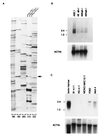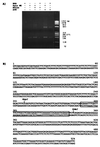Identification and characterization of the ARP1 gene, a target for the human acute leukemia ALL1 gene
- PMID: 9539779
- PMCID: PMC22531
- DOI: 10.1073/pnas.95.8.4573
Identification and characterization of the ARP1 gene, a target for the human acute leukemia ALL1 gene
Abstract
ALL1, the human homologue of Drosophila trithorax, is directly involved in human acute leukemias associated with abnormalities at 11q23. Using the differential display method, we isolated a gene that is down-regulated in All1 double-knockout mouse embryonic stem (ES) cells. The gene, designated ARP1 (also termed RIEG, Ptx2, or Otlx2), is a member of a family of homeotic genes containing a short motif shared with several homeobox genes. Using a bacterially synthesized All1 polypeptide encompassing the AT-hook motifs, we identified a 0.5-kb ARP1 DNA fragment that preferentially bound to the polypeptide. Within this DNA, a region of approximately 100 bp was protected by the polypeptide from digestion with ExoIII and DNase I. Whole-mount in situ hybridization to early mouse embryos of 9.5-10.5 days indicated a complex pattern of Arp1 expression spatially overlapping with the expression of All1. Although the ARP1 gene is expressed strongly in bone marrow cells, no transcripts were detected in six leukemia cell lines with 11q23 translocations. These results suggest that ARP1 is up-regulated by the All1 protein, possibly through direct interaction with an upstream DNA sequence of the former. The results are also consistent with the suggestion that ALL1 chimeric proteins resulting from 11q23 abnormalities act in a dominant negative fashion.
Figures






References
Publication types
MeSH terms
Substances
Associated data
- Actions
- Actions
- Actions
- Actions
- Actions
Grants and funding
LinkOut - more resources
Full Text Sources
Other Literature Sources
Molecular Biology Databases
Research Materials
Miscellaneous

